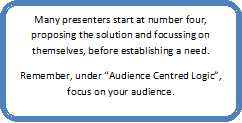|
1.
Presentation Structure
Logic: Commence with your story
When
crafting a story, cover your topic in a logical order, moving your audience
through a series of logical steps.
Jim Endicott
presented the following structure, which I have used and adapted over time:

A good, logical structure is:
-
Identify the “pain”.
What is the pain point of the audience, or the problem? Why is this issue a
problem for the audience”? Make sure it is not just your problem!
-
Quantify the impact.
How big a problem is it and what does it cost your audience, either in pain
or in dollars?
-
Specify the need.
Now is the time to hone in on possible solutions. What is needed to ease or
fix the problem? This step will lead your audience to your next point.
-
Propose the solution.
Suggest what is needed and why. This is where you introduce your solution,
and yourself.
-
Quantify the value.
Demonstrate the value of your solution for your audience. This is where you
demonstrate the merit of the solution.
-
Sell your advantage.
Why are you the person to deliver this solution to your audience?
-
Substantiate your claim.
Don’t just tell your audience you can provide the solution… prove it.

So, I would take this:
-
Companies need good analytical data on who they employ, what
they are doing and what their strengths are, as well as projected needs of
the company.
-
Good morning; I’m Sarah Johnson from “My-company” and I’d
like to demonstrate some exciting developments our company is doing in terms
of future casting of Australian workforces.
-
Our company provides 120 Australian companies with the data
they need to forecast their workforces. Analysis shows these companies are
98.2% happy with the solution.
-
Estimates suggest a lack of good HR data costs Australian
businesses $850 million each year, not accounting for direct costs to
employees, both personal and financial.
-
With 80 staff in 12 countries, we have worked with some of
the world’s largest corporations, including HR Place who commented: “We
thought we knew our workforce and how to position them. We were wrong.
“My-company” showed us how to fix it”.
-
Concern is growing over the cost of poor human resource
information currently available to Australian companies.
-
Preliminary data from the software system we launched 3
years ago has enabled companies to reduce their HR costs by an average 12%
in the first 3 years, up to a high of 43% over that time period.
And turn it into this:
| Story structure |
Example |
1. Identify the “pain
|
Concern is growing over the cost of poor human
resource information currently available to Australian companies. |
2. Quantify the impact
|
Estimates suggest a lack of good HR data costs
Australian businesses $850 million each year, not accounting for
direct costs to employees, both personal and financial. |
3. Specify the need
|
Companies need good analytical data on who they
employ, what they are doing and what their strengths are, as well as
projected needs of the company. |
4. Propose the solution
|
Good morning; I’m Sarah Johnson from “My-company”
and I’d like to demonstrate some exciting developments our company
is doing in terms of future casting of Australian workforces. |
5. Quantify the value
|
Preliminary data from the software system we
launched 3 years ago has enabled companies to reduce their HR costs
by an average 12% in the first 3 years, up to a high of 43% over
that time period. |
6. Sell your advantage
|
Our company provides 120 Australian companies with
the data they need to forecast their workforces. Analysis shows
these companies are 98.2% happy with the solution. |
| 7. Substantiate your claim |
With 80 staff in 12 countries, we have worked with
some of the world’s largest corporations, including HR Place who
commented: “We thought we knew our workforce and how to position
them. We were wrong. “My-company” showed us how to fix it”. |
This logical process also works for creating a story out of very large
documents. Work through the document and code it with the above stages. That is,
write the stage number beside each paragraph for you to later incorporate into a
logical presentation.
Notice! You do not need to talk about yourself until section four!!!
|

